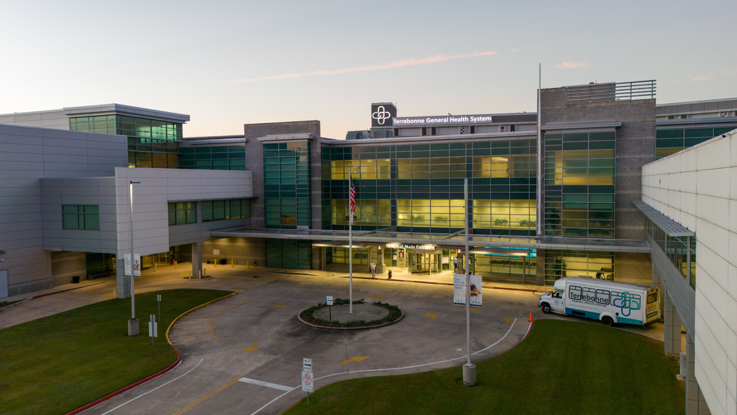Gear Up, Game Up: Back-to-School Sports Prep
- Category: Must-reads
- Posted On:
- Written By: Dr. Patrick St. Martin, Sports Medicine

As the school year approaches, student-athletes are gearing up for another exciting sports season. Whether it’s football, volleyball, cross country, or any other activity, preparation is key to staying healthy and performing your best. Dr. Patrick St. Martin, Sports Medicine physician, gives expert advice on how students can safely and effectively get ready for the sports season.
- What are the most important things student-athletes should do before returning to school sports?
At least six weeks before the season, each athlete should undergo a sports physical by his or her physician to address any health concerns and ensure safe engagement in sports. Athletes should also address any previous injuries and focus on recovery before entering the season. As discussed below, conditioning programs are important before the start of the season.
- How early should students start training or conditioning before the season begins?
There is no specific timing of off-season strength and conditioning programs; the timing depends on the particular athlete's level of fitness and the specific sport that the athlete plays. Off-season conditioning programs should include aerobic conditioning, flexibility or stretching, and muscular strengthening. Athletes should spend 3-5 days per week on aerobic activities (running, bike riding, and swimming) for about 20-60 min per session, depending on the exercise intensity. Resistance training and weight lifting, 2-3 days per week, help improve strength and muscle development.
When preparing for the season, athletes should engage in sports-specific strength and conditioning programs. Participation in these programs is associated with lower rates of injuries. A qualified adult should supervise weight-lifting programs, focusing on proper form and mechanics. Heavy lifting, such as snatch cleans and jerking, is not recommended in younger athletes who are still growing.
- What are the most common sports-related injuries in young athletes, and how can they be prevented?
Young athletes still growing are especially prone to overuse injuries, such as those affecting the growth plates. These injuries include Little League shoulder, Little League elbow, lower back stress fractures, and stress reactions of the knee and ankle. These injuries most commonly present between the ages of 11 and 16. A well-known risk factor for these injuries is playing one sport at the exclusion of other sports and activities, which is known as “sports specialization.” This is considered sports specialization if an athlete plays one sport for >8 months per year. Prevention is key to avoiding these injuries, so emphasis on proper sports form, proper weight lifting, protective equipment, and avoidance of early sports specialization is encouraged. Additional athletes should take a break from a particular sport for 3-4 months per year and have 1-2 days off from sports activities in a given week.
- What role does stretching and warm-up play in injury prevention?
In general, sports research has not consistently shown that stretching and warm-ups prevent injuries. However, pre- and in-season training programs that focus on strength training and balance training are effective in reducing injury rates.
- How can parents or coaches recognize the signs of overtraining or burnout in student-athletes?
Overtraining and burnout are important to recognize earlier in the process. A coach or parents may notice that an athlete seems less interested in sports or that his or her performance is declining. You may also notice mood changes such as anxiety, depression, anger outbursts, and complaints of muscle fatigue. As described earlier, sports specialization is a risk factor for overtraining and burnout. If your athlete or child is experiencing these symptoms, it may be time to take a break from organized sports. To prevent the likelihood of an athlete developing burnout, emphasis should be placed on skill development instead of competition and winning.
- How important is hydration, and what are your tips for staying hydrated during hot practices?
Even a mild amount of dehydration affects athletic performance. Only a 2% loss of body water leads to a decline in muscle function and the brain's ability to work correctly. Some strategies can be used to prevent dehydration. Athletes should weigh themselves before either practice, games, or training, and then weigh themselves afterwards. For each 2 lbs. of weight loss, 30-50 ounces of fluids should be consumed. For activities that lasted >60 minutes, sports drinks that include sugar, salt, and other electrolytes should be consumed.
- Why are sports physicals or pre-participation exams important before the season starts?
Numerous physician organizations recognize and support each athlete undergoing a pre-participation sports physical by his or her primary physician at least 6 weeks before the start of practices. Ultimately, these physicals ensure that an athlete can safely participate in sports. These evaluations are important to identify life-threatening conditions, including heart conditions. Existing or past injuries can be identified and treated before the athlete begins play. Additionally, common chronic conditions such as obesity, high blood pressure, and asthma can be identified and treated.
- How much rest and sleep should student-athletes be getting during the season?
The amount of sleep that student-athletes need will vary somewhat person to person, but there are general guidelines based on age: 9-11 hours for children ages 6-13 and 8-10 hours for teenagers ages 14-17.
- What are your top tips for healthy recovery after games or intense practices?
There are several aspects to staying healthy and recovering properly. Athletes should follow a balanced diet focusing on whole food ingredients such as fruits, veggies, meats, nuts, and whole grains. Do your best to avoid processed, convenient food items. Sleep is essential to recovery; poor sleep can lead to poor athletic and school performance. As discussed previously, hydration, hydration, hydration. Follow the weight method as discussed previously to avoid dehydration. If there are concerns for burnout in your athlete, schedule an appointment with your physician and consider taking a break from organized sports. If an injury does occur, seek medical treatment from your physician or a sports specialist such as myself.
At Terrebonne General Sports Medicine, we believe that every athlete deserves top-notch care and support to stay at the peak of their game. To schedule an appointment with Dr. Patrick St. Martin, call 985-873-GAME(4263).
References:
- Pollock, Michael L. Ph.D., FACSM (Chairperson); Gaesser, Glenn A. Ph.D., FACSM (Co-chairperson); Butcher, Janus D. M.D., FACSM; Després, Jean-Pierre Ph.D.; Dishman, Rod K. Ph.D., FACSM; Franklin, Barry A. Ph.D., FACSM; Garber, Carol Ewing Ph.D., FACSM. ACSM Position Stand: The Recommended Quantity and Quality of Exercise for Developing and Maintaining Cardiorespiratory and Muscular Fitness, and Flexibility in Healthy Adults. Medicine & Science in Sports & Exercise 30(6):p 975-991, June 1998.
- The Team Physician and Strength and Conditioning of Athletes for Sports: A Consensus Statement. Medicine & Science in Sports & Exercise 47(2):p 440-445, February 2015. | DOI: 10.1249/MSS.0000000000000583
- Lintner LJ, Swisher J, Sitton ZE. Childhood and Adolescent Sports-Related Overuse Injuries. Am Fam Physician. 2023 Dec;108(6):544-553. PMID: 38215415.
- Lauersen JB, Bertelsen DM, Andersen LB. The effectiveness of exercise interventions to prevent sports injuries: a systematic review and meta-analysis of randomised controlled trials. Br J Sports Med. 2014 Jun;48(11):871-7. doi: 10.1136/bjsports-2013-092538. Epub 2013 Oct 7. PMID: 24100287.
- DiFiori, John P. MD*; Benjamin, Holly J. MD†; Brenner, Joel MD, MPH‡; Gregory, Andrew MD§; Jayanthi, Neeru MD¶; Landry, Greg L. MD‖; Luke, Anthony MD, MPH**. Overuse Injuries and Burnout in Youth Sports: A Position Statement from the American Medical Society for Sports Medicine. Clinical Journal of Sport Medicine 24(1):p 3-20, January 2014. | DOI: 10.1097/JSM.0000000000000060
- Nutrition and Athletic Performance. Medicine & Science in Sports & Exercise 48(3):p 543-568, March 2016. | DOI: 10.1249/MSS.0000000000000852
- Am Fam Physician. 2020;101(11):692-694
- Ng AE, Adjaye-Gbewonyo D, Black LI. Regular Bedtimes Among Children Aged 5-17 Years: United States, 2020. NCHS Data Brief. 2022 Jun;(437):1-8. PMID: 35792633.



